
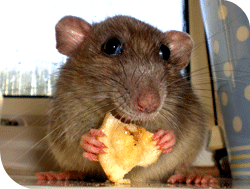
 Rats and mice are important rodent pests entering homes and warehouses for food and harborage.
Rats and mice are important rodent pests entering homes and warehouses for food and harborage.
 Rats contaminate 10 times as much food as they eat, with urine, droppings and hair
Rats contaminate 10 times as much food as they eat, with urine, droppings and hair
 They can carry at least 10 different kinds of diseases including bubonic plague, murine typhus,
They can carry at least 10 different kinds of diseases including bubonic plague, murine typhus,
spirochetal jaundice, Leptospirosis, rabies, ratbite fever, and bacterial food poisoning
 Rats and mice also start fires by gnawing matches and electrical wires in homes
Rats and mice also start fires by gnawing matches and electrical wires in homes
 The Norway rat, roof rat and house mouse are the most persistent rodent populations in need of control
The Norway rat, roof rat and house mouse are the most persistent rodent populations in need of control
NORWAY RATS (Rattus norvegicus)
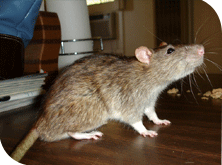
 The Norway rat, also called the brown rat or sewer rat is a destructive pest found in urban and
The Norway rat, also called the brown rat or sewer rat is a destructive pest found in urban and
suburban neighborhoods
 Norway rats are husky, brownish rodents that weigh about 11 ounces
Norway rats are husky, brownish rodents that weigh about 11 ounces
 They are about 13 to 18 inches long including the 6 to 8 1/2 inch tail
They are about 13 to 18 inches long including the 6 to 8 1/2 inch tail
 Their fur is coarse and mostly brown with scattered black on the upper surfaces
Their fur is coarse and mostly brown with scattered black on the upper surfaces
 Their droppings are 3/4 inches long and capsule-shaped
Their droppings are 3/4 inches long and capsule-shaped
 Norway rats generally prefer to eat fresh meat, fish, and grain, they can survive quite well on an ounce
Norway rats generally prefer to eat fresh meat, fish, and grain, they can survive quite well on an ounce
per day of garbage or decayed food along with an ounce of water
 Norway rats are burrowers and often dig in rubbish and under buildings or concrete slabs
Norway rats are burrowers and often dig in rubbish and under buildings or concrete slabs
 Burrowing can cause damage by undermining the foundations of buildings, disfiguring landscape
Burrowing can cause damage by undermining the foundations of buildings, disfiguring landscape
plantings and blocking sewer lines
 Norway rats live about 1 year and reach sexual maturity in 3-5 months
Norway rats live about 1 year and reach sexual maturity in 3-5 months
 They have 8-12 young per litter and up to 7 litters per year
They have 8-12 young per litter and up to 7 litters per year
ROOF RATS (Rattus rattus)
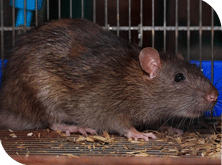
 Roof rat is also commonly known as the black rat and ship rat
Roof rat is also commonly known as the black rat and ship rat
 Color ranges from black to grizzled gray to tan with a light belly.
Color ranges from black to grizzled gray to tan with a light belly.
 The tail is longer than the combined head and body
The tail is longer than the combined head and body
 Droppings are up to 1/2 inch long and spindle-shaped
Droppings are up to 1/2 inch long and spindle-shaped
 Roof rats thrive in attics, roof spaces, palm trees, and ornamental shrubbery
Roof rats thrive in attics, roof spaces, palm trees, and ornamental shrubbery
 They are climbers and prefer to nest off the ground
They are climbers and prefer to nest off the ground
 They can be quite destructive in attics, gnawing on electrical wires and rafters
They can be quite destructive in attics, gnawing on electrical wires and rafters
 Roof rats generally prefer vegetables, fruits and grain; but they consume ½ to 1 ounce per day
Roof rats generally prefer vegetables, fruits and grain; but they consume ½ to 1 ounce per day
of food from various sources
 Roof rats live about 1 year and reach sexual maturity in 3-5 months
Roof rats live about 1 year and reach sexual maturity in 3-5 months
 They have 6-8 young per litter and up to 6 litters per year
They have 6-8 young per litter and up to 6 litters per year
HOUSE MICE (Mus musculus)
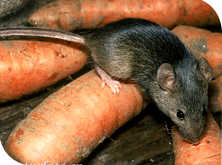
 House mice are considered among the most troublesome and economically important rodents
House mice are considered among the most troublesome and economically important rodents
 The house mouse is a small, slender rodent that has a slightly pointed nose; small, black, somewhat
The house mouse is a small, slender rodent that has a slightly pointed nose; small, black, somewhat
protruding eyes; large, sparsely haired ears; and a nearly hairless tail with obvious scale rings
 Droppings are 1/8 inch long and rod-shaped
Droppings are 1/8 inch long and rod-shaped
 House mice live in and around homes, farms, commercial establishments, and in open fields and agricultural lands
House mice live in and around homes, farms, commercial establishments, and in open fields and agricultural lands
 Prefer to feed on grains but usually nibble at a wide variety of foods
Prefer to feed on grains but usually nibble at a wide variety of foods
 House mice live about 1 year and reach sexual maturity in 6 weeks
House mice live about 1 year and reach sexual maturity in 6 weeks
 They have 5-6 young per litter and up to 8 litters per year
They have 5-6 young per litter and up to 8 litters per year
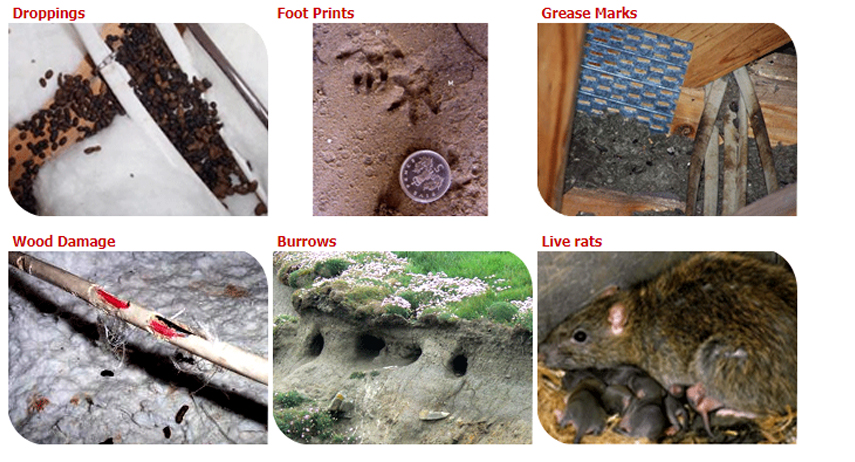
These diseases can be spread to humans directly, through handling of live or dead rodents, through contact with rodent feces, urine, or saliva, and through rodent bites. Below is a summary of some of the most common diseases associated with rodents: Hantavirus, Lymphocytic Choriomeningitis, tularemia, and Plague.
1. Hantavirus Pulmonary Syndrome
2. Hemorrhagic Fever with Renal Syndrome
3. Lassa Fever
4. Multi-mammate rat (Mastomys natalensis species complex)
5. Leptospirosis
6. Muskrats and possibly narrow-skulled voles
7. Lymphocytic Chorio-meningitis
8. Omsk Hemorrhagic Fever
9. Plague
Verminex® PEST CONTROL HAS BEEN PROVIDING EFFECTIVE SOLUTIONS FOR GETTING RID OF RODENTS. CONTACT US FOR ESTIMATE FOR YOUR HOME OR BUSINESS.